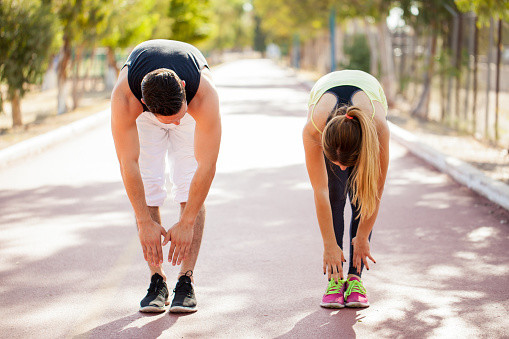Running News Daily
Running News Daily is edited by Bob Anderson. Send your news items to bob@mybestruns.com Advertising opportunities available. Train the Kenyan Way at KATA Kenya and Portugal owned and operated by Bob Anderson. Be sure to catch our movie A Long Run the movie KATA Running Camps and KATA Potato Farms - 31 now open in Kenya! https://kata.ke/
Index to Daily Posts · Sign Up For Updates · Run The World Feed
Stretching was once the cure-all for running injuries.
When it comes to running, experts want you to avoid static stretching
Stretching was once the cure-all for running injuries. Practitioners would ask injured runners if they were stretching enough, and if the answer was no they would offer more stretches. However, research is now suggesting that certain kinds of stretching aren’t great for runners, and may even be harmful for those who are prone to injury.

According to a literature review of several studies, there’s actually a correlation between lower levels of flexibility and better running economy, which refers to the amount of energy expended to maintain a particular speed. A study on untrained runners found that participants with the lowest flexibility happened to have the most naturally economic running styles. Researchers believe that this was a result of low range of motion, leading to better stabilization when the foot hits the ground. Basically, excessive range of motion means more energy is needed to stabilize muscles, and having a lower range of motion reduces that use of energy.
Carla Robbins is the owner of Vital Strength and Physiology in Calgary, Alta. She says she almost never prescribes static stretching to her clients – she’s all about strength work. “If stretching is something you do frequently, it’s technically possible to get more length in the muscle, but I don’t personally recommend it. I feel like there are other things that can check that box, for example, dynamic stretching or strength training. Strength training results in strength (and length), while also preventing injury.”
When To stretch - If static stretching (holding one position) isn’t recommended for runners, then what should they be doing to warm up? Robbins says ideally runners will integrate dynamic stretching (not holding the stretch, but moving with control in and out of the end ranges of the stretch) into their pre-run routine. A dynamic warmup will increase body temperature, which activates enzymes that are beneficial to running.
When not to stretch - Robbins says static stretching should be avoided by runners who are trying to prevent (or rehabilitate) an injury. “There isn’t enough evidence to support that stretching prevents injury,” she explains. “Some stiffness is required in the ligaments and muscles to run. For example, if you’re a hyper-mobile person with relaxed ligaments, you might be more prone to injury as your joints are more likely to move with loading. Lack of stiffness isn’t necessarily beneficial.”
Robbins also reminds runners never to stretch through pain. “Listen to your body, it’ll tell you if you’re doing something wrong.
”What about cramping?
When runners cramp up, many feel the need to “stretch it out,” but the research is divided on the topic. Muscle cramps can be caused by many factors including dehydration, fatigue and vitamin or mineral deficiencies. Leg cramps can also be a side effect of some prescription medications.
However, the reason for cramping and its exact cure eludes us. Several studies suggest that stretching out a cramp won’t hurt you, but it won’t necessarily help, either. If cramping is an issue for you, Hyland’s Leg Cramp Tablets, an official sponsor of the Boston Marathon, are one way to feel confident on the start line. Hyland’s Leg Cramps Tablets are taken without water, the quick dissolving tablets melt instantly in your mouth for fast-acting natural relief of leg, calf and foot cramps with no known side effects. They can be purchased on Amazon.ca and ship worldwide.
What muscles should runners pay attention to?
Robbins is a big fan of strength training, which both lengthens and strengthens muscles. In addition to making runners stronger, it’s a great way to prevent injury. “For example, if you’re super stiff and have no hamstring flexibility, but also continually injure your hamstrings, you could look at training that muscle,” she says. “Train at the end of a muscle’s range of motion (a deep deadlift is an example) so that you not only develop length, but also strength in the long term. Studies comparing stretching protocols to strengthening protocols have shown that a runner can improve injury-resilience with strength training and joint mobility without ever stretching.”
When strength training, runners should pay special attention to their quads and hamstrings, along with ankle and hip mobility. These are the areas where the most-common running injuries tend to happen.
by Running Magazine
Login to leave a comment




